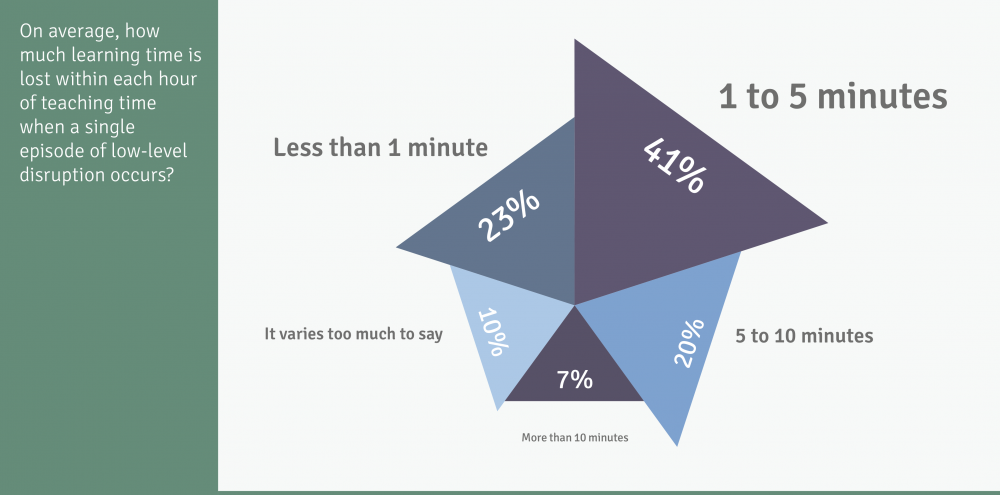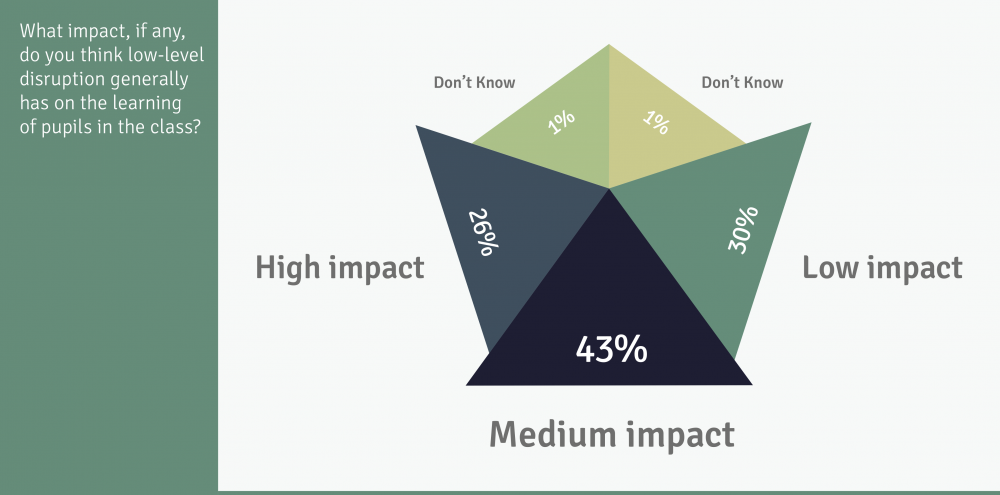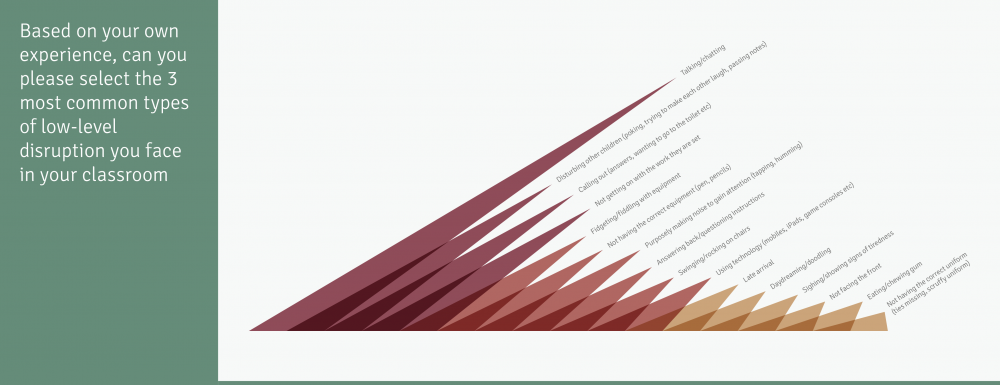According to Ofsted, up to an hour of learning every day is being lost to ‘low-level disruption’. So how can you prevent it from affecting your classroom? International behaviour expert Dr Bill Rogers gets to the heart of how to get around such disruptions.
Friday, a Year 8 class: 25 students file into class after lunch break. Dean ‘playfully’ punches Ibrahim (“You w***er!â€). Melissa and Chantelle are still texting. There’s a lot of residual and loud social chatter as the students take their seats. Several students still haven’t turned their phones off … Dean and Ibrahim start fiddling with the cords on the window blinds … Craig and Mohammed are chatting and leaning back heavily in their chairs … Bilal is fiddling with a McDonald’s toy. All this is happening as the teacher is seeking to ‘settle’ and focus the 25 students for – yet another – learning activity.
At this stage, less than five minutes after the bell, the teacher hasn’t begun to teach and engage learning. The teacher still has to focus the students’ attention and engage their learning interest and activity, as well as address calling out and ‘social chatting’ while the teacher is engaged in whole-class teaching time.
These distractions and disruptions are sometimes denoted (in the literature) as ‘low-level’ and are one of the more common behaviours that teachers have to address in more challenging schools. Most people (outside the teaching profession) have little idea of what day-to-day teaching is really like and what teachers have to address in their classrooms.

It’s not just the natural demands of teaching within (and ‘to’) the National Curriculum; it’s the percentage of students with diagnosed (or symptomatic) behaviour disorders and learning disorders; students whose home lives are significantly dysfunctional (involving domestic violence, substance abuse, a poor home diet, and so on). And remember – again – that teachers have to work with and support these students for a significant period of their waking day.
Of course, the degree to which so-called ‘low-level’ disruptions continue (within a lesson) or become significantly disruptive to learning and relationships depends on the behaviour leadership skill of the teacher and their ability. Nevertheless, it is a challenging and demanding task to enable a workable and co-operative teaching and learning culture in that small room, day in, day out.
I have spent most of my professional life seeking to address these concerns, particularly in very challenging school communities. While it is not possible in a short article to address the significant skills teachers need to address behaviour and enable a positive teaching and learning and relational culture, the essential areas to understand and address are outlined below…
A school-wide establishing of arights/responsibilities culture
The right to feel safe in a school; the right to be treated fairly (without discrimination); the right to learn without distraction and disruption. These rights are not negotiable: they are the foundations of everything we do within our school communities.
These rights will be challenged by human nature; this is ‘normal’, but we must lead, teach and discipline from and to the protection of those rights, from ‘low-level’ disruptions through to the more serious behaviours in our schools.
Establish a positive behaviour leadership culture
This is where the significant skills of discipline and behaviour management are crucial to enabling (and protecting) a rights-enhancing culture. In the establishment phase of the year it is essential to develop clear, positively experienced rules (where possible) and routines for student entry to a classroom and settling (with natural restlessness) right through to fair rules for classroom discussion; noise levels; movement etc. (Rogers, 20111).
Wherever we discipline we seek to (wherever possible) communicate and convey a sense of calmness in our language. Our ‘calmness’ is not some quiescent passivity or artificially ‘holding in our feelings’. Such ‘calmness’ is also not un-emotional; it is about clear, respectful communication.
Calmness (in the sense used here) is in part communicating our appropriate confidence as a teacher-leader and, in part, it is also conveying the sense that our students can trust us to manage the teaching/learning dynamic in classrooms. It is seen in the characteristic way we communicate (particularly when under pressure).
Students sense – indeed they know – such ‘calmness’ in teachers through the characteristic tone and manner in our voice, our body language and conveyed intent.
Such calmness is necessary, for example, when we cue for whole-class settling, attention and focus at the beginning of a lesson, and when addressing any distracting and disruptive behaviour. It is crucial when dealing with frustrated or angry students (or parents).
Communicating and conveying calmness is not inconsistent with appropriate assertion where necessary (assertion is to be distinguished from pettiness, mean-spiritedness, hostility or verbal aggression).
Assertion is a skill; when we speak assertively we speak in a clear, firm and decisive way, emphasising that we seek to protect the fundamental rights of students and teachers alike. We do so in a way that does not intentionally invoke hostility or verbal aggression…
Least to most intrusive rule
Remember the least to most intrusive rule (wherever possible) when intervening in any corrective/discipline exchanges and in any context. Least intrusive interventions could be as basic as non-verbal cues or a brief description of the reality/a rule reminder or simple direction.
A descriptive cue, for example, when speaking to the boys fiddling with the window blinds: “Sean ( … ) Bilal ( … ) you’re fiddling with the window blinds, it’s really distracting.†(This describes the behaviour reality.) We often need to follow up with a brief direction cue: “Leave the blinds, thanks, and face this way.†The direction is positive and behaviourally focused [“leave … faceâ€] rather than “Don’t fiddle with the window blinds†(which only tells the student what we don’t want them to do). At this point the teacher will redirect her attention back to the whole class to convey take-up time.

When we are more intrusive (in discipline interventions) there will be a corresponding ‘moral weight’ directing the degree/kind of intervention we make regarding behaviour issues such as repetitive disruptions; any situation where there is a potential safety concern, or a student behaving aggressively, dangerously or abusively.
In effect, the least-to-most principle maximises appropriate (and fair) ‘choice’ given by the teacher to the student regarding their behaviour. Such ‘choices’ are directed within the fundamental rules and responsibilities and rights in a school. A typical, and basic, example is when we direct a student to put their iPod, phone, loud keyring, distracting toy or whatever away “in your bag or on my table until the end of the lessonâ€. This is in preference to merely taking it or simply demanding that the student hand it over: giving a directed choice also minimises unnecessary confrontation, and increases co-operation.
Positive corrective language
Where possible, our behaviour management focuses on the ‘do’ (in the behaviour we address) rather than over-focusing (or over-using) the ‘don’t’. For example, “Hands up, thanks†rather than “Don’t call outâ€; “Facing this way and listening, thanks†rather than “Don’t talk while I’m teachingâ€; “Remember our class rule for…†rather than “Don’t forget the rule for …â€.
You could also use, “When … then†(i.e. a conditional direction) rather than, “No, you can’t, because …â€. Any sense of positive corrective language is also significantly affected by our characteristic intent/manner, by our tone of voice and the degree of confidence that is present in any discipline communication (not bossiness or arrogance) (Rogers, 2011).
Keep your focus (of reminding/correcting/disciplining) directed to the primary behaviour or issue…
Avoid over-servicing ‘secondary behaviours’ (or secondary issues) unless necessary. It is very easy for students to distract our leadership focus by an extended sigh; a whining voice; minimal eye contact; the attentional tone of their voice; a sibilant (or not so sibilant) mutter; eyes raised to the ceiling; a muttered last word, and so on.

These secondary behaviours can easily distract us when we are leading a class or engaging disruptive students in one-to-one exchanges in class (or non-class) settings. Our ability to utilise skills such as tactical ignoring; paying selective attention; descriptive and directional cues; partial agreement; directed choices; consequential choices and refocusing and thoughtful use of take-up time (in the language we use when addressing student behaviour) all have a significant effect in minimising unnecessary confrontation and engaging students’ compliance – and perhaps even their co-operation.
Detailed discussions on how we engage typical secondary behaviours in student discipline are developed at length in Rogers (2011) and Rogers and McPherson2 (2014).
Always follow up and follow through with a student (one on one) on issues that matter. This enables appropriate repairing and rebuilding of relationships and (where necessary) restitution. Some issues cannot be effectively addressed in the social setting of a classroom – they need follow-up.
Any distraction or disruption (and often there are several in more challenging classes) needs handling with conscious skill, based on the sorts of understandings noted here. Where teachers lead in this way, they enable the relational confidence and trust from their students that is essential to enable a positive and co-operative learning culture. SR




